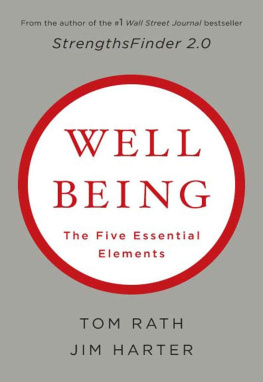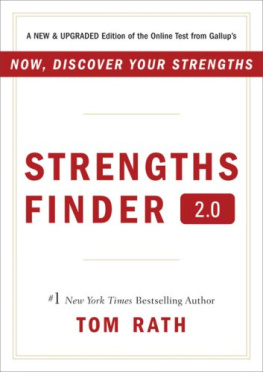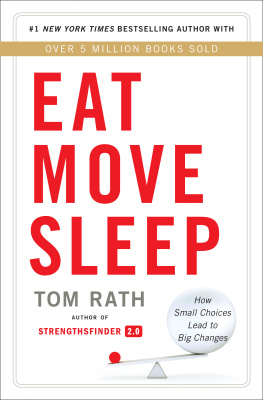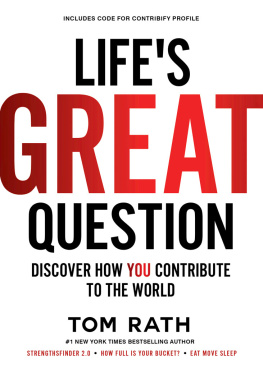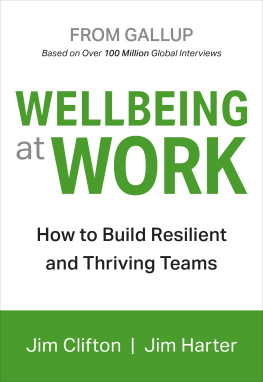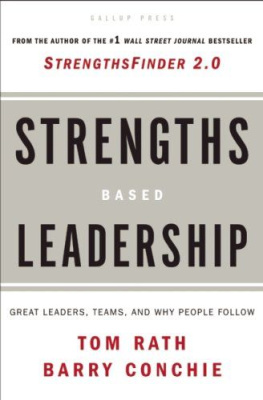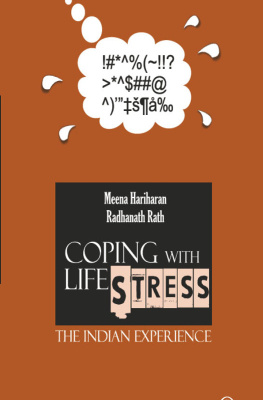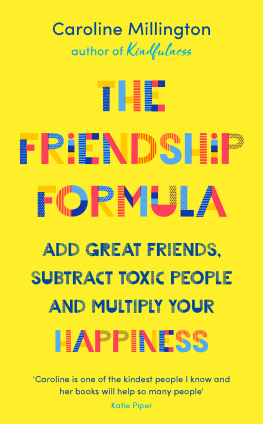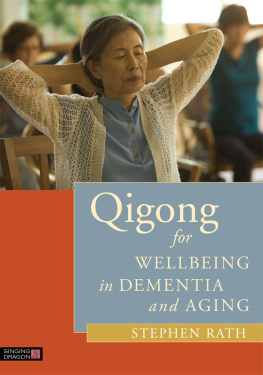Who picks you up when youre down and need someone?
Whom do you trust the most with a burning secret you need to share? Who would never tell another soul?
Who gives you advice if youre having problems with a colleague at work?
Who is the first person you call when you want to go out, relax, and have a good time?
Who will sit down and truly listen to every word you say when you want to share a story?
Who knows how to push you to do more to achieve more?
Who always seems to anticipate what youre going to say next before the words even leave your mouth?
Who would stick up for you at work if your job were on the line?
Who runs around telling others how great you are?
Who are your Vital Friends ?
GALLUP PRESS
1251 Avenue of the Americas
23rd Floor
New York, NY 10020
ISBN-13: 978-1-59562-036-1
Copyright 2006 The Gallup Organization
All rights reserved, including the right of reproduction in whole or in part in any form.
Gallup, Clifton StrengthsFinder, Gallup Press, Q12, StrengthsFinder, and The Gallup Poll are trademarks of The Gallup Organization, Washington, D.C. All other trademarks are property of their respective owners.
The Q12 items are protected by copyright of The Gallup Organization, 1993-1998. All rights reserved.
to Ashley, my Energizer for eternity
CONTENTS
SOMETHINGS MISSING
The energy between two people is what creates great marriages, families, teams, and organizations.
Yet when we think consciously about improving our lives, we put almost all of our effort into self -development.
As I look back on my formal education, it was based almost entirely on mastery of a topic or building my knowledge base. In grade school, I learned how to read, multiply, and write, and I struggled to grasp a foreign language. During college and graduate school, I had the opportunity to focus on even more specific topics that piqued my interest. Throughout my professional life, I have attended countless development programs that aimed to make me more productive.
Even when I have dedicated time to developing others, my attention has focused on each persons self -development.
I had it all wrong. The potential was hiding within each relationship in my life.
Tom Rath
PART ONE:
FRIENDS IN LIFE
CHAPTER 1:
WHO EXPECTS YOU TO BE SOMEBODY?
How did you end up on the streets?
Roger, a big burly man, sat in silence and stared at me, a nervous, skinny interviewer with wire-rimmed glasses. He thought about the question for a few minutes, the words echoing through his head as he searched for a response. Seated in a chair three feet in front of him, I eagerly awaited his reply.
Roger scratched his head and caught me glancing at his hand. His rough, leathery skin had clearly endured the elements during the two decades he had been on the streets. His nails were caked with dirt, and his hollow eyes revealed an emptiness that I could see even before I asked the first question. Roger described to me the great life he once had. He had grown up in a wonderful home, was married right after graduating from college, found a job with a respectable mechanical engineering firm, bought a house and two cars, and had three children by the age of 30. To my surprise, Roger had lived a very normal life.
Then, Roger explained to me what had happened so many years ago to change all that. He described how his frustration at work was increasing each day. His only real friend at work, Jimmy, had been fired. Aside from his wife, Jimmy was Rogers best friend in the world. They joined a bowling league together, went on hunting trips every November, and their families were close. Roger and Jimmy had offices right next to each other, and they talked every day not just about work, but about personal matters as well. Their friendship kept both men engaged in a job that would have otherwise been dreary. Since Jimmys termination, Roger could hardly muster the motivation to go to work.
For eight years, Roger and Jimmy were forced to tolerate the same boss, Mike, a hostile man who took every opportunity to remind his employees how much seniority he had with the company. Mike would belittle Roger, Jimmy, and other employees at every turn. As Roger described Mike, you could tell that he was one of those managers whose abrasive demeanor inflicted damage far beyond the nine-to-five workday. When Roger recounted stories about Mike, his jaw tightened, and he raised his lower lip into a scowl. He seemed to be seething with hatred.
Rogers peers at work didnt make the situation any better they all suffered through Mikes abuse in stoic silence. After Jimmy was fired, Roger was left with his boss and a few other engineers who didnt say much. They rarely socialized on the job. Everyone was simply punching a clock at work, eager to get out of there at the end of the day.
By the time Roger finished work each evening, he needed an escape. So he began drinking. At first, Roger stopped by the neighborhood bar one or two nights a week. Soon, that became five or six nights of heavy drinking. Even though his family tried hard to reverse his downward spiral, he began to self-destruct.
As Roger described his wifes efforts to help, the pain in his voice spoke volumes. He could not bring himself to call her by name during our interview, nor did he ever mention his childrens names. At the age of 32, Roger had lost his job, his wife, and his children. He had moved into a small apartment. For six months, his mother paid his rent and tried desperately to help him. Roger continued to push her away. Like the others, she eventually gave up on him out of frustration.
Left with no means of support, Roger was forced to live in his car. One day, he returned from his daily journey scrounging for food and found that even his meager home was gone. The police had impounded his car because of back taxes and unpaid parking tickets. Roger was officially homeless for the first time in his life.
Roger recounted this last part of the story in a dry, matter-of-fact tone. I could tell that the real turning points the moments that had scarred his memory for 20 years were Rogers final conversations with friends and loved ones. Once the relationships were broken, little else mattered.
As Roger finished his lengthy reply to my question, he could sense that the interview was drawing to a close. But I had one last question:
Who expects you to be somebody?
Roger paused for a moment, took a deep breath, and said, I dont think anyone does anymore.
PROJECT RECOVERY
In 1991, I was invited to work on a special research study on homelessness. The projects aim was to help shelters and city missions develop better programs for people in need. My assignment, in partnership with several other researchers, was to conduct a series of interviews. Armed with our questions and tape recorders, we visited homeless shelters, city missions, and gathering places for the needy. Over the span of four months, we interviewed hundreds of men and women around the country. Our goal was to answer one main question:
Why do some people emerge from homelessness and recover, while others do not?
To answer this question, we started by interviewing people who were homeless and not headed toward recovery (according to experts in each community). My initial suspicion, likely rooted in age-old stereotypes, was that most homeless men and women were in their situation as a result of extreme alcohol or drug abuse. So we asked several questions designed to uncover such dependencies. Sure enough, many of the people I spoke with had severe addictions, and some suffered from serious mental illnesses.
Next page

